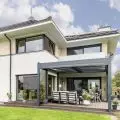Annually, buildings account for about 39 percent of global carbon emissions related to energy consumption. If sustainability goals are to be achieved, the industry must move away from a "take it, make it, throw it away" approach. Arup, an international firm specializing in sustainable engineering, has produced a report showing how designers can create in line with the regenerative concept. The firm presents such innovative projects as a building created to resemble a termite mound, or the granting of rights that establish the subjectivity of a river.
© ARUP
One-third of the world's waste is generated exclusively within the built environment, making large-scale contributions to biodiversity loss, resource depletion and greenhouse gas emissions.[1] Arup's new global report, "Regenerative Design," inspires the industry to make the changes needed to stop the planet's degradation, showing how designers around the world are looking for ways to regenerate the planet. Already, dozens of cutting-edge designs are emerging - from a building in Harare, Zimbabwe, designed to resemble a termite mound to provide cooling without air conditioning, to recognizing the Whanganui River in New Zealand almost as a living being to enable action to be taken in court against those who pollute it. According to Arup experts, it is this scale of change that will be necessary for the industry to reverse its environmental impact and have a positive effect on both people and the planet.
nature-inspired solutions
Regenerative design involves reconnecting natural cycles where we disrupt them with our functioning. Consequently, a building created in accordance with this concept should, like any organism in an ecosystem, not only draw on its neighborhood, but also add value to its surroundings. An example of a nature-based design can be found at Eastgate in Harare, Zimbabwe, where biomimetics was used to design the cooling system. In nature, termites build mounds, resembling skyscrapers, which are ventilated by a universal tunnel system. Based on this concept, engineers placed an extensive exposed thermal mass in the facility, developed shading in the building's exterior, and used ventilation shafts to create a chimney effect that lowers the temperature. As a result, Eastgate has no conventional air-conditioning or heating system, only a ventilation system that costs about one-tenth the price of an air-conditioning system in a building of comparable size and significantly reduces energy consumption.
- Our engineering skills have been shaped over the past thousands of years, while solutions present in nature have been refined by nature for millions, so today they are becoming an invaluable source of inspiration, including in building design. To create according to the concept of regenerative design, we must place nature at the center and build in conjunction with nature. Such measures in practice mean, among other things, designing water-saving systems that take advantage of the flora and fauna surrounding the building, supporting waste decomposition with organisms that have evolved to do so, or modeling a closed-loop economy based on existing ecosystems, says Anna Bak, Sustainability Team Leader at Arup.
extending the systems approach
In regenerative design, it is also important to understand the systems associated with an object and build a connection between them. Currently, systems created by humans are based on waste. More than 100 billion tons of resources are extracted worldwide each year, of which only 7.2 percent are reused.To change this, it is necessary to extend the approach in design, using materials, resources and relationships that restore, protect and replenish. An example of a project pursuing these goals is The Demolition Protocol in Singapore, implemented by the building construction agency, which involves recycling almost all construction waste. It requires assessing the reusable parts of a building and removing any potential contamination before demolishing the rest of the structure. The protocol has made more popular new types of materials and techniques that make maximum use of existing construction waste. Concrete is now made from demolition waste, and metals are recovered using magnets and screening techniques.
Inclusivity and equity
Thoughtful transformation also requires policies that ensure inclusiveness and equity, regardless of the geopolitical situation. Accordingly, social, economic and environmental factors should be seen as parts of a system that provides clean water, food and other goods and services, but at the same time takes care of the planet. In line with this concept, New Zealand's legislation recognized the Whanganui River in New Zealand as a legal entity. The river had been overexploited by extracting minerals from its bed, and the local Lwi tribe had been trying for centuries to improve its welfare and provide protection. Standard methods did not produce the desired result, so the New Zealand legislature recognized nature as a stakeholder, and the indigenous people, as stewards of the land where it ran. What's more, an 80-million-dollar fund has been set up to repair the damage caused to the river.
The construction industry is one of the main areas of green transformation, but it still pays too little attention to its environmental impact. In the report, "Regenerative Design," Arup points out that reducing resource consumption is not enough, and it is necessary to simultaneously address the climate and nature crisis, taking into account existing ecosystems. The entire report is available on the website here.

















